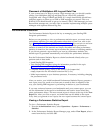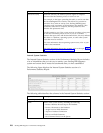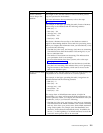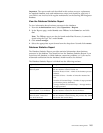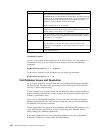
Statistic Name Description
Persist a Business
Process Step to the
Database
The length of time and the number of times a business process
step was persisted to the database.
For more information about persistence, refer to the topic
Changing Persistence Levels.
For example, in the figure preceding this table, Persist a Business
Process Step to the Database had the following statistics:
v Min (ms) – 5
v Max (ms) – 391
v Average (ms) – 59.0
v Invocations – 163
v Total (ms) – 9735
The Persist a Business Process Step to the Database statistic is
helpful in determining database issues and slow processing issues.
When you compare this information with your benchmarks, verify
if you notice the following:
v The Min (ms), Max (ms), and Average (ms) times are increasing.
This indicates that either the database is becoming full, or you
have a connection leak.
v The number of invocations are increasing. This indicates that
your persistence level is set too high.
For more information about slow systems, refer to the topic
Changing Persistence Levels.
v The number of invocations is small and the Min (ms) and Max
(ms) times are increasing. This indicates that you are persisting
large documents to the database, which can be moved to the
disk to save database space.
Assign from an XPath
Statement
The length of time and the number of times an assign activity was
completed from an XPath statement in a business process.
For example, in the figure preceding this table, Assign from an
XPath Statement had the following statistics:
v Min (ms) – 2
v Max (ms) – 43
v Average (ms) – 10.0
v Invocations – 29
v Total (ms) – 310
The Assign from an XPath Statement statistic is helpful in
determining if you have well-structured XPath statements in your
business processes. When you compare this information with your
benchmarks, verify if you notice the following:
v The Min (ms), Max (ms), and Average (ms) times are increasing.
This indicates that the XPath statement is not written efficiently,
and may slow down your process time. Write XPath statements
using relative paths. For example, write PurchaseOrder/text
instead of /ProcessData/PurchaseOrder/text(). In addition, do
not use // at the beginning of an XPath statement, because this
causes the entire process data to be traversed.
Performance Management 211



